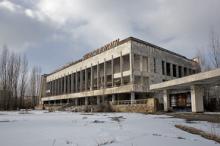In 1986 the nuclear reactor in the Ukranian town of Chernobyl went red. This plant had no containment shell, and when it blew, it poured a plume of radioactive fallout into the air above the nearby town of Pripyat. The plume followed easterly winds and over the next week it settled over the Soviet Union, moving slowly eastward to Europe.
The official Ukranian government death toll stands at about 50, the number of workers who were killed directly by the explosion. But the number of people who died as a result of the long-term effects of contamination may number up to a million.
After the explosion, the government created the Exclusion Zone, also called the Zone of Alienation. The borders of the Exclusion Zone are monitored by military personnel, and even today, it is difficult for visitors to receive the clearances and safety training required for entry.
The Exclusion Zone has a radius of roughly 20 miles from the nuclear reactor, although its specific boundaries follow landscape features and take account of the fallout's drift patterns. It includes the town of Pripyat, which had held a population of about 50,000 people. Pripyat, now abandoned, is the focus of many visitors' interest. Its overgrown streets, dilapidated housing, and eerie silence make for fascinating photography, and are a study in post-apocalyptic progression.
Pripyat is also famously said to be haunted. Perhaps its existing cadre of ghosts failed to evacuate with the living, or perhaps they are the spirits of those who died in the explosion, or from the radioactive fallout. Destination Truth traveled to Pripyat, and shot one of the best episodes of the series there.
The explosion also created the "red forest," named for the color of the dead pine trees found there. The trees died en masse after the radioactive fallout, but life has rebounded to a startling extent inside the Exclusion Zone. Although still radioactive, no mutations have been recorded among the wild animals which thrive there. However, most experts agree that a thorough veterinary survey (impossible for several reasons) would no doubt reveal a high level of cancer and tumors among the wildlife.
Nevertheless, wild animals which once flourished across Eastern Europe, but which were almost eradicated by encroaching civilization, has returned in vast numbers. Wolves, brown bear, European wisent (a forest buffalo), elk, moose, Przewalski's horses, wild boar, roe deer, and beaver populations are all thriving in the absence of humanity.
This has posed two problems. First, the bounty tempts poachers - who, aside from operating illegally, then take their poached and radioactive game to market in populated area. And second, the radioactive animals are gradually pushing out from the boundaries of the Exclusion Zone, creating something of a situation in adjoining countries.
The radiation from Chernobyl was and continues to be a serious problem. However, radiation levels outside the Exclusion Zone are within acceptable parameters. It's worth noting that, although there are many towns within the 19-mile zone from the Fukushima Daiichi plant, Tokyo itself is almost 150 miles away.
Photo credit: Flickr/Pedro Moura Pinheiro
